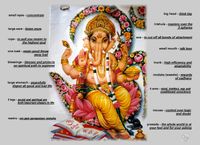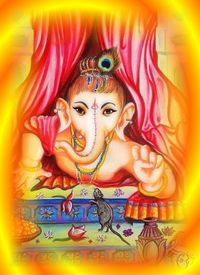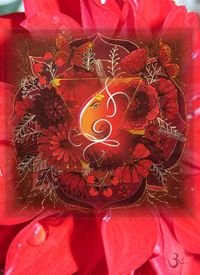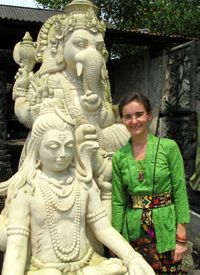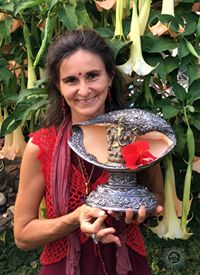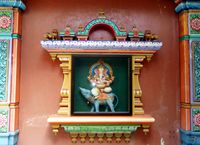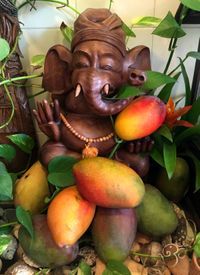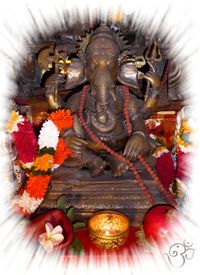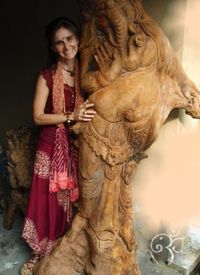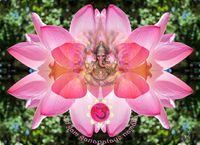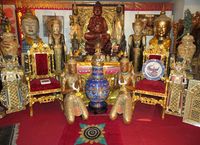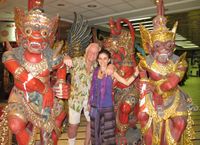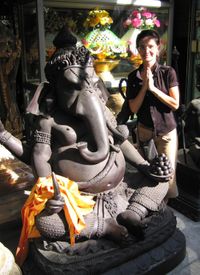ॐ एकदन्ताय विद्धमहे, वक्रतुण्डाय धीमहि, तन्नो दन्ति प्रचोदयात्॥
Om Ekadantaya Viddhamahe, Vakratundaya Dhimahi, Tanno Danti Prachodayat॥
Who is my beloved Ganesha?
Ganesha is the formless Divinity - encapsulated in a magnificent form of a human body with an elephant head. You just have to love Ganesha because he's so funny on the one hand. He dances, makes music and loves pranks. On the other hand, he embodies wisdom and awareness. Ganesha is the energy of the divine that encourages us that we don't necessarily have to live ascetically to be religious! On this page I have put together all my contributions that explain Ganesha to you.
Gan-esha. Gan means group. The universe is made up of a group of atoms and different energies. Our universe would be in chaos if there were no cosmic law that regulates these different groups of energies that exist - the being, the concrete and the abstract. The Lord of all these groups of atoms and energies is Ganesha. He is the highest consciousness that permeates everything and brings order into this universe.
And here is “my” essence of Lord Ganesha.
Ganesha - the source of learning
Ganesha is the remover of obstacles, the patron of arts and sciences and the deity of intellect and wisdom. As the deity of beginnings, he is honoured at the start of rites and ceremonies. But did you know that Ganesha is also a source of learning? Every part of Ganesha's body teaches us something and has a deep spiritual meaning. And that's what I want to tell you about in this post. There are 32 forms and 108 names of Ganesha and each form has certain attributes. I chose one of the most common forms, the Vinayaka with the four arms, sweets, axe and rope. I took the photo in 1999 in Old Delhi. It was a little poster on an old house.
In the picture, Ganesha is sitting in an OM symbol. It's called “oṃkārasvarūpa”, the manifested form of the cosmic sound OM or AUM. Ganesha is identified with the mantra OM. OM refers to the notion that Ganesha personifies the primal sound. This is confirmed in the ancient writings of Ganapati Atharvahirsa. It says: “Oh Lord Ganapati, you are the Trimurti, the unity of Brahma, Vishnu and Maheshwara (Shiva). You are Agni, the fire. You are Surya and Chandra, sun and moon. You are Brahman. You are the three spheres of life (remember the Gayatri-Mantra: Bhur, Bhuvaha, Swaha!), Bhuloka, the earth, Bhuvarloka, the space, and Swargaloka, the heaven. You are the OM. Oh Lord Ganapati, you are all this!” Ganesha is the same energy which is the reason for this universe. It is the energy from which everything manifests and into which everything will dissolve. When Ganesha embodies all that is and we become one with him (for example singing the mantra), then we feel that we are also one with existence.
Ganesha's big head means "think big!"
No wonder Lord Ganesha is worshiped as the god of wisdom. Its elephant head indicates intelligence and discernment. The elephant is endowed with unusual characteristics, such as its fearless and majestic gait. It destroys every obstacle on its way. An elephant is also a symbol of self-confidence, perseverance, strength and courage. To symbolize these qualities of the divine, Ganesha is represented in the form of an elephant. And when we become one with Ganesha, we can absorb all of these qualities into our consciousness.
Ganesha’s small eyes symbolize concentration.
Ganesha’s eyes teach us to concentrate our mind. Mindfulness is the ability to be fully present, to be aware of where we are and what we are doing, and not to get so distracted by what is going on around us. You can practice mindfulness by sitting down, closing your eyes and watching your breath. Or you look into a light or a figure like Ganesha. You can also practice mindfulness in daily dealing with the things that you do. It's actually quite simple. Just concentrate on what you are doing and don't do something else at the same time. Mindfulness makes you sensitive. You will make up your own mind about what is right.
Ganesha’s Big Ears mean “listen more”.
Ganesha’s wide ears denote the ability to listen to people who seek his help. Ears are also used to gain knowledge. They signify the importance of listening in order to absorb ideas. But first listen! My beloved Guruji Osho always reminded us of the importance of listening. So to really listen, that is, just listen and not judge the other person's words straight away or misinterpret them with your own ideas. Then you hear everything that hovers like a fragrance between the words. With Osho it was the silence. True listening opens up other spheres.
Ganesha’s Trishul mark on his forehead
The Trishul is the weapon of Shiva, his father. The Trishul symbolizes life, which consists of three spheres: creation, maintenance, and destruction; past, present, and future; body, mind and atman; compassion, joy and love; spiritual, psychic and relative; clarity, knowledge and wisdom; heaven, mind and earth; and so on. The Trishula on Ganesha’s forehead symbolizes these spheres and Ganesha's mastery over it. So when we become one with Ganesha, then these three, I'll call them states of being, dissolve.
Ganesha’s Small Mouth means "talk less"
His mouth teaches us to believe in doing instead of talking. To value our words. To listen, think, do- and then talk. There are mutliple reasons for this. On the one hand, it is often better to take a deep breath before, for example, responding to rather negative conversations. If you look from a little distance, you may see that there is also a spark of truth in the other person's statement. On the other hand, speaking takes a lot of energy. Energy that you may urgently need for something else. I often find myself trying to speak. So no short conversation, but long conversations. And especially when I later realize that it has not led to anything. When you are on a spiritual path, silence is the greatest good. Use your energy to come to your center. And then something else. Have you not already noticed that the most important things in life do not need any language at all? You feel it!
Ganesha’s Single Tusk indicates Ganesha’s ability to overcome all forms of dualism.
We live in a world full of duality. But isn't it precisely this being torn between the worlds that divides us? This constant thinking between darkness and light? Duality creates problems. When I see, feel and live everything as a unit, then peace arises in me. One does not exist without the other. If I think carefully, there is really only that which is full of light. Darkness is just abstinence from light. Everything "negative" is just abstinence from the "positive". Can there be hatred when love is there? Is there an end? Is there a beginning? We tend to think that we end when our bodies end in the material world. This duality is created by the mind which creates the ego. Duality is the screen keeping us from realizing our real Self, which is beyond body and mind. Once we transcend this duality, we see the entire Universe as a single whole and we become aware of our true Selves. One of the key attributes of people who are Self-Realised is that they rise above their likes and dislikes and the pairs of opposites that world presents before them. Established in the permanent Divinity, they remain unperturbed by what the world has to offer; the joys and sorrows, the victories and losses. They understand the ways of the world. Giving their best at every juncture, yet understanding that, in the ultimate analysis, it is only a game. Relatively speaking, genuine seekers on the spiritual path also achieve this sense of peace to the extent that they have identified with the Self. This transcendence over the pairs of opposites (two tusks) in a person of perfection is indicated beautifully by Ganesha’s broken tusk.
Ganesha`s trunk
The trunk of Ganesha is a symbol of many things, and the side it is bent to is a symbol of what the image of Ganesha means, how it should be worshiped and what we can learn from it.
The elephant is the only creature that can perform all of its functions with its trunk. It smells, eats, drinks, bathes and works with its trunk. Ganesha's trunk is a symbol of the perfect balance between knowledge (Gyaan Shakti) and action (Karma Shakti). Ganesha uses his trunk to destroy obstacles and advance. It is also twisted and symbolizes the sound of OM, the universal sound. Have you ever seen the Tamil Omkara sign? It really looks like Ganesha's head. I put it on the picture as a kind of watermark. The trunk of Ganesha means flexibility and the ability to adapt and change over time. Perhaps you have already noticed that there are figures with the trunk turned to the left. But then there are also some with a straight trunk (rather rare) and then also those with the trunk to the right, as in my picture. I better do another post about the special meanings. Now I am explaining Ganesha based on this picture and thus the trunk to the right.
Ganesha with the trunk to the right appear almost exclusively in temples. These images are fervently and religiously venerated. The right side trunk is called "Siddhi Vinayaka". Ganesha is accompanied by two Shaktis, Siddhi and Buddhi. Siddhi lives on his right and therefore the idol with a trunk bent to the right is called Siddhi Vinayaka. The trunk on the right side symbolizes freedom from all worldly pleasures and the attainment of moksha. Therefore, such a figure is rather not for house altars, since people with families have duties and cannot let go of joys. Ganesha with the trunk to the right is connected to the energy of the sun. In yoga the pingali is called nade. You may have heard of this before when you were engaged in pranayama breathing. Just as the sun can both create and destroy, this Ganesha can lead you to happiness or put obstacles in your way because existence wants to help you get on the right path. So if you get involved in a Gansha with a trunk to the right, it would be good if you use the mantras correctly (i.e. pronunciation, rhythm and the right accompanying music) and familiarize yourself with the customs of worshiping Ganesha.
The four arms of Ganesha
Ganesha holds various objects in his four hands. These objects are all symbols of spiritual action and show us, how Ganesha can help us. They indicate how we can connect with the energy of Ganesha to remove obstacles (in all day live or on the spiritual path). But the arms themselves also have a meaning:
The four arms of Ganesha represent the four inner attributes of the subtle body. That is the mind (Manas), the intellect (Buddhi), the ego (Ahamkara) and the conditioned conscience (Chitta).
In the version of Ganesha that I chose for my explanation, my beloved deity has four hands.
In one hand he holds a rope, which represents Ganesha’s ability to help pull us up towards our ultimate goal of realization and liberation.
Another hand holds an axe to cut all attachments with the impermanent and material world we continually grasp for. The hand waving an axe is a symbol of the detachment of all desires, bearers of pain and suffering. The axe is intended to remind us that we have the opportunity to resolve problems and obstacles. In the end, they are just obstacles to our mind.
In his third hand, he holds a bowl full of laddus, sweets, which represents rewards for spiritual development. Ganesha is never shown eating the laddus. The wise man never partakes of the rewards of his deeds. He is not attached to them.
His fourth hand is shown in a mudra, with the most common depiction of him showing the blessing mudra, which looks almost identical to the “Abhaya” or “fearless” mudra. Ganesha offers protection and guidance to the spiritual seeker. We must also offer that same grace and blessings to those we meet on the path of life. This hand gesture is taken by many deities as a way of blessing those who worship them.
Ganesha’s “Cosmic” Big Belly
Ganesha’s belly contains infinite universes, the seven realms above and below and the seven oceans are inside Ganesha's cosmic belly. The big belly signifies also his over activated kundalini energy which he had stored in his navel.
The big cosmic belly signifies the ability of Ganesha to swallow the sorrows of the universe and protect the world. It is said that Lord Ganesha's belly is considered a symbol of happiness. His big belly means to understand the good and bad things, that is, digest them properly and then give your decision. So you will attain the virtue of calmness.
Ganesha’s legs
Perhaps you have already noticed that Ganesha only touches the earth with one foot. The other leg is either in the meditation pose above the knee or it is half in the air as in the dance position. In my selected picture you don't see it so clearly, but only the left foot touches the earth, the left foot is a little higher. There are also Ganesha representations where this is not the case, for example when he is standing, crawling on the floor as a child or sitting in a yoga asana. But there, too, his two legs represent the social world on the one hand and the spiritual world on the other.
Social and spiritual are both important phases in life. The position of his legs indicate a way of living. It’s important to live in the social as well as in the spiritual world. When Ganesha is shown sitting with one foot on the ground and the other resting on his knee or above the ground, it means: Be in the world but not of it!
Ganesha’s Vahana (animal vehicle) the rat/mouse
Ganesha is often shown seated in front of a tray of Prasad, a devotional offering of sweets, fruits, food,etc. In these images Ganesha’s Vahana, the rat, is shown sitting in front of him, perhaps a bit to one side, looking up at him. The rat is a symbol of our senses, which are never satisfied. They crave new experiences, new tastes. Left uncontrolled, they keep growing forever. But a wise person rides on his senses (you have probably seen a Ganesha representation before, in which he is sitting on his rat). He keeps the senses (rat) under control. In the representation on my picture it means:
The senses of the wise person are under his control and the rat dare not eat the “Prasad” without the permission of Ganesha.
Ganesha sitting on a lotus flower
In general, lotus flowers represent spiritual enlightenment, growth, purity, and birth. Also the cycle of life, death, and rebirth. The lotus symbolizes one’s ability to perform their duty without being influenced by any desire, pleasure, or gain.
I hope that with the description of Ganesha, you could convey something about how Ganesha can help us. Ganesha is a great guru to us. Every part of the body, every attribute that he holds in his hands that accompanies him has a meaning. And all of these meanings are meant to remind us how to manage our lives.
When we recite "Om Gam Ganapataye Namaha" before starting anything what we are saying is that "In what we are about to do, let wisdom be our guide". In a way, Ganesha is our most powerful god, and he is usually called before we start rituals for other deities, before we start anything.
ॐOm Gam Ganapataye Namahaॐ
There are different versions of the birth of Ganesha. The most common is the following story:
Once upon a time, Shiva went to meditate on the top of the mountain Kailash and left his wife Parvati at home alone. Parvati was then harassed by numerous admirers. After he didn't come back for years, the admirers said "He'll never come back". Then Parvati created Ganesha as pure being (Suddha) from the scrapped skin of her body at bath time and placed him in front of the entrance of her house. She instructed him not to let a man come near her and gave him supremacy over the heavenly hosts. Years later, Shiva remembered that he had completely forgotten his wife while meditating, and returned to his house. Ganesha stood there and denied him entry. Shiva did not accept that, a fight ensued and Shiva cut off Ganesha's head. Parvati was extremely angry about this: “You killed my son, go back to your mountain! I never want to see you again! ” Shiva was angry with himself. That was not how he had imagined his homecoming. He withdrew and looked for a solution. He then ordered his servants to bring him the head of the first creature they would find. However, this creature would have to face north. The servants made a thorough search and found only one elephant in that position. The elephant's head was cut off and taken to Shiva, who then placed it on Ganesha's body. Shiva made sure that from then on people invoke and worship Ganesha at the beginning of the day and all activities.
The Brahmanda Purana tells a different story about Ganesha's birth:
Once upon a time demons created obstacles and prevented souls trapped in worldliness from finding salvation. The goddess Devi (Parvati) saw this sad game and in her compassion she decided to put an end to this evil. Because the demons dared to put obstacles in the way of even the gods! At this point Devi looked into Shiva's face and smiled. From the “Shine” of her smile emerged a deity with an elephant face. Devi used this deity to stop the demons. Vighneshwara (name of Ganesha), the remover of obstacles, was born. He destroyed the blockages on the path of the gods.
Which one is true? My heart says: the second!
Ganesha is the god of intellect and wisdom, the destroyer of selfishness and pride. He is said to be the embodiment of the elemental universe in all its various shapes and forms. He is the "Lord of Beginnings", so not only does the week begin with my Ganesha reminder, but every Hindu prayer and tantric worship begins with a dedication to Ganesha. This is the only way to ensure that something is fruitful. He himself is full of devotion and although nothing begins without him, he is by no means aloof or narcissistic. Ganesha is not born naturally, but Parvati created him from the scales of her skin. He should protect her from intruders. When Shiva, Parvati's consort, came home, Ganesha would not let him through the door. He didn't know him. After not even Brahma or Vishnu could convince Ganesha that Shiva was the master of the house, Shiva in his anger decapitated Ganesha. He was later brought back to life. Since the head was lost in battle, it was replaced with a head from the first creature found. It was an elephant. Now when I look at this painting and see the devotion with which Ganesha worships the Shivlingam, the symbol of Shiva, I feel love. Shiva took his first life from him and yet Ganesha gives himself full of love to Shiva. There is no anger, no grudges, but peace of mind. His second birth has made him grow spiritually, made him my beloved Ganapati who encourages me every day to overcome obstacles, problems and conflicts (internal and external) with wisdom and creativity.
After a “Chai-Time” gathering with Deva Premal and the Gayatri-OMline-Ashram, I realized once again how terrible it is when you suffer. There are so many different forms of suffering, emotional, physical ... certainly everyone has already suffered, but there are people for whom the suffering does not want to end. Illnesses, pain, loss ... as an outsider difficult to empathize and yet everyone, the whole environment is affected. That's why I want to pass on my energy all the more. From my own experience, everything in my life has a purpose, there is a cause, and there is a way. The path is not always recognizable at first glance, but it is possible to walk with confidence. Trust in the divine, trust in existence, trust in my inner voice. Trust in my own inner strength. These are four sentences and yet the energy is the same! I trust. And out of this trust I keep my happiness and healthiness. With this trust I get well again and again. From this trust I also draw the strength to overcome obstacles. I didn't meet Ganesha for nothing, I'm quite sure of that!
I already told you the story of the birth of Ganesha. As is so often the case in Hinduism, there are several stories and now I would like to tell you these one. Quite interesting that God Vishnu gave him the elephant's head - for love! In our Ashram we dedicate a different mantra every day and when I wrote this post it was: Om Parama Prema Rupaya Namaha! This mantra requests the manifestation of Divine Love in a person's life, in a form the person can comprehend. I find this story with Vishnu interesting because Ganesha often plays tricks on him. The perspective probably decides that: Am I a follower of Shiva (and his family) or a follower Vishnu?
Of all the wonderful Hindu deities, Shree Ganesha is closest to the material level of consciousness and best able to support us in our daily life problems.
Perhaps you feel drawn to Ganesha and are now asking yourself: How can I reach Ganesha and get his help? Very easy. To contact Ganesha, hold his appearance firmly in your head with your eyes closed. You can talk to him now. He will listen but not speak back. Just put all your questions and problems at his feet and then open your eyes. Speak them out, put them down mentally. Have faith. Ganesha does not answer you with words, but by slowly and invisibly influencing events and decisions. The situation will change for you and doors will open to him through your prayers.
It is said that the following mantra has the power to dissolve through Ganesha's blessings all kinds of suffering caused by negative energies. For example, also through karmic previous loads of a person. With this mantra it can be balanced. So it's a harmonizing mantra. It can help remove obstacles and adverse circumstances.
OM GAM GLAUM GANAPATAYE VIGHNA-VINASINE SVAHA
OM = the sound of the universe
GAM (Gum) = means to move, let go, bring about
GLAUM is another bija (seed) mantra from Ganesha. It activates my willpower for letting go of old behavioral patterns, thus creating a new beginning. It activates my willpower to lead a life in meditation and to act out of it, too. And it activates my willpower to be myself.
GANAPATAYE = Ganapati is another name of Ganesha, the remover of obstacles.
VIGHNA-VINASINE= refers to Ganesha's power to remove suffering and obstacles
SVAHA= With Svaha one expresses that the power of the mantra, the power of the ritual, may be effective as a blessing power
Be aware, that Ganesha is in everybody of us, in every atom of the universe.
I have already told you about the story of Ganesha's birth. In it also occurred how Ganesha got his elephant head. Do you remember that?
Be aware, that Ganesha is in everybody of us, in every atom of the universe.
Ganesha and the golden mango
My day begins with the Ganesha mantra and on this photo you see the Ganesha, in front of which I sit every morning full of joyful love and recite the Ganesha-Mool-Mantra:
OM GAM GANAPATAYE NAMAHA
It is a statue depicting Ganesha as a child. He doesn't have many arms yet and his right tusk is still intact. This Ganesha sits in our bathroom. Every room is sacred to me. I have Ganesha statues in “important places” throughout the house. Everywhere they should remind me that there are obstacles to arouse creativity in me. Obstacles make me grow. The statues also remind me that I don't have to live ascetically to be spiritual. The worldly belongs to the whole just as much as the spiritual. The statues remind me to be mindful and conscious.
The one who circles the world three times first is the winner and gets the golden mango!
Ganesha's answer made a deep impression on his parents because he said:
"My parents are my universe and my whole world! So if I circle you, it means that I have circled the whole world!"
Certainly wisdom and intelligence always come out on top in the end. But I also learn from it that I shouldn't always start running. In a figurative sense, this also means that I shouldn't always react the same way. First take a deep breath. After that everything looks different and I act with awareness.

